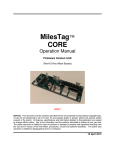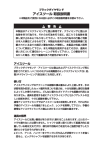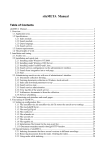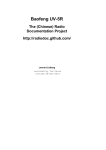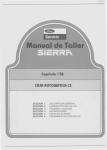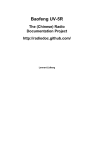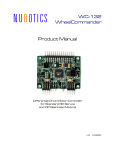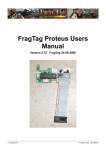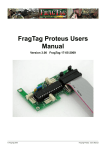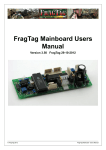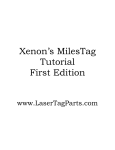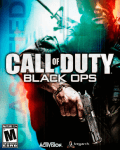Download User Manual for CORE & RevG
Transcript
MilesTag CORE Operation Manual Firmware Version 5.41 (RevH Main Boards) NOTICE: This document and the systems described herein are protected by international copyright laws. It may not be reproduced in full or in part, for any purpose public or private, without the express written consent of the author. All features, specifications and information detailed in this publication are subject to change without notice. Use of the information and the systems described is entirely at your own risk. The author assumes no liability for injury to persons or damage to property and equipment resulting from the use and or misuse of the information, procedures, circuits and systems described. The author also assumes no liability for typographical errors or omissions. 7 Mar 2010 DISCLAIMER OF WARRANTIES & LIMITATION OF LIABILITY Combat TAG, LLC makes no warranty, either express or implied with respect to any product or service, and specifically disclaims all other warranties, including, without limitation, warranties for merchantability, non-infringement and fitness for any particular purpose. Combat TAG's sole obligation and liability for product defects shall be, at Combat TAG's option, to replace such defective product or refund to buyer the amount paid by the buyer therefore. In no event shall Combat TAG's liability exceed the buyer's purchase price. The foregoing remedy shall be subject to the buyer's written notification of defect and return of the defective product within ninety (90) days of purchase (date of invoice). The foregoing remedy does not apply to products that have been subjected to misuse (including without limitation static discharge), neglect, accident or modification, or to products that have been soldered or altered during assembly, or are otherwise not capable of being tested, or if damage occurs as a result of the failure of buyer to follow specific instructions. In no event shall Combat TAG be liable to the buyer or to any third party for any indirect, incidental, special, consequential, punitive or exemplary damages (including without limitation lost profits, lost savings, or loss of business opportunity) arising out of or relating to any product or service provided or to be provided by Combat TAG, or the use or inability to use the same, even if Combat TAG has been advised of the possibility of such damages. “Laser Tag Parts” and “MilesTag™” are alternate business names of Combat TAG, LLC. www.lasertagparts.com www.CombatTAG.com READ THIS !! This is an operation manual for the MilesTag 5.41 operating system and the MilesTag CORE RevH main board. Details of tagger construction or programming are not covered in this document. READ THIS !! Firmware for the PIC18F2525 microcontroller and sound effects (wav files) are available for free download from www.LaserTagParts.com/mtcore.htm. If you want to program the microcontroller yourself, you will need a “PIC programmer” that supports the PIC18F2525. This is a good idea as you may need the programmer to update your taggers when new firmware is released, rather than sending your PICs in for update. Firmware is updated regularly to address bug-fixes and feature updates. We do not provide information or assistance on PIC programming. There are numerous websites, manufacturers and support forums dedicated to this. Please refer to the manufacturer of your programmer for assistance. Preprogrammed microcontrollers, printed circuit boards and other parts are available from http://shop.LaserTagParts.com. 2 OVERVIEW OF SYSTEM FEATURES o o o o o o o o o o o o o o o o o 50 Players 4 Teams Fully editable gun and game configurations Full-Auto Switch New! Support for Medic Box and Ammo Box “pick-ups”. Players can “pick up” additional Health and Clips on the field Adjustable “Barrel Overheat” function Automatic Respawn – Adjustable Time Delay Automatic Timed Games – Game Over after time limit expires Electronic “Flags” – Sensor LEDs flash to indicate “carry”; drop flags when killed Updated: ”Zombie” game mode – dead players come back?. as zombies! Gun-to-gun wireless “Cloning” allows instant configuration of additional taggers Intelligent display backlight control Anti-cheating features Infrared (IR) LED fail monitor w/ alarm (RevG hardware only) Precision battery monitor w/ low battery warning Built-in Referee Gun functions (any tagger can be configured as the Ref Gun) Built-in ISD recorder function for uploading custom sound effects (RevH hardware only) No need to purchase external sound chip programmer. Built-In Referee Gun (Master Controller) Features: o New Game, Admin Kill, Respawn, Pause o Collect Scores, View Scores (individual & team), send scores to PC o Test Sensors Add-on Devices Supported: o Micro MT Taggers (uMT) (uMT taggers support limited feature set / no scoring) o Flag Station - up to 16 unique flags o Medic Box – up to 16 medic boxes (pick-ups) o Ammo Box – up to 16 ammo boxes (pick-ups) o Respawn Station o First Aid Kit (Medic) o Ammo Can (Armorer) o Grenade (Instant Kill or Variable Damage) o Claymore (Instant Kill or Variable Damage) o Bazooka (Variable Damage) o Stun Grenade (6-second stun/flash-bang) o Bomb / Trip Mine (Instant Kill) o Radiation Emitter (Area Denial; Variable Damage) 3 RevH CORE MAIN BOARD PARTS LIST QTY 1 1 1 1 1 1 5 1 1 1 7 2 4 3 1 1 1 2 1 1 1 1 PART # / VALUE PIC18F2525-I/P ISD1790 L4941BV TDA7052BN 16MHz 1N4001 IRLD110 330uF, 25V 100uF, 25V 2.2uF .1uF, 50V 22pF, 50V 10K ohm 51 ohm 17K ohm 2K ohm 4.7K ohm 1.65K ohm, 1% 39K ohm 60.4K ohm, 1% 3.3 ohm 1M ohm MFR Microchip Nuvoton ST Micro NXP Semi 2 3 2 1 1 1 1 1 1 1 22-23-2021 22-23-2041 22-23-2061 640445-2 Molex Molex Molex Amp Vishay MT-PCB-RevH MilesTag PART # / VALUE NMTCS0802XFGHSAY-10 MFR Microtips EG2624 E-Switch 7.2V, 3200mAH 8 ohm, .5W TSAL6100 TLCR5800 Vishay Vishay DESC Microcontroller Chipcorder, 90 seconds, sound effects 5V regulator, low-dropout, TO-220 BTL audio amplifier, 1W, w/ volume control 16MHz microprocessor crystal, HC-49U Diode, Rectifier HEXFET, 4-pin DIP, logic-level Electrolytic capacitor, 3.5mm lead spacing Electrolytic capacitor, 2.5mm lead spacing Electrolytic capacitor, 2.5mm lead spacing Ceramic chip capacitor, 2.5mm lead spacing Ceramic chip capacitor, 2.5mm lead spacing Resistor, ¼ watt, 5% Resistor, ¼ watt, 5% Resistor, ¼ watt, 5% Resistor, ¼ watt, 5% Resistor, ¼ watt, 5% Resistor, ¼ watt, 1% Resistor, ¼ watt, 5% Resistor, ¼ watt, 1% Resistor, ¼ watt, 5% Resistor, ¼ watt, 5% 28-pin DIP IC socket, .3” width 28-pin DIP IC socket, .6” width 8-pin DIP IC socket 2-pin header, .1”, KK friction-lock 4-pin header, .1”, KK friction-lock 6-pin header, .1”, KK friction-lock 2-pin header, .156”, KK friction lock 2x2 header, .1” pin spacing 2x3 header, .1” pin spacing Insulator, mica, TO-220 Screw, 4-40 Nut, 4-40 PC Board, MilesTag CORE (RevH) NOTES U1 Blank chip requires firmware U3 Blank requires recording U2 U4 X1 Only on newer boards C1 C2 C10 C3,C4,C7,C8,C9,C11,C12 C5,C6 Oscillator caps Battery monitor Volume set – 39K to 82K ISD1790 oscillator – 12KHz L4941 insulator L4941 tab L4941 tab OTHER PARTS QTY 1 1 1 1 1 1 1 1 1 1 1 1 1 1 2 3 2 1 2 S22-USB-SERIAL-INTCONN CAB-2C CAB-4C CAB-6C 09-50-8023 08-50-0106 MISC Acroname DESC LCD display module, 8 character x 2 lines LCD cable, 14C ribbon w/ 2x7 connectors Switch, key-operated, SPDT Button, SPST, momentary, normally open Button, SPST, momentary, normally open Switch, SPST or SPDT (slide or toggle) Button, SPST, momentary, normally open NiMH or NiCad rechargeable battery pack Speaker, mylar cone Infrared LED, 1.5A “Muzzle Flash” LED, ultra-bright, red 2.5mm x 5.5mm DC power jack 3.5mm stereo jack Serial to TTL adapter for score transfer MilesTag 2-pin mating cable, Molex KK, .1” spacing MilesTag 4-pin mating cable, Molex KK, .1” spacing MilesTag 6-pin mating cable, Molex KK, .1” spacing Molex 2-pin crimp terminal housing, .156”, KK Molex Crimp terminal, .156” Lens, lens tube, wire, solder, battery charger 4 NOTES Backlight requires modification Key removable both positions “Display” button, BLACK “Reload” button, RED “Semi-Auto / Full-Auto” switch “Trigger” button 2000mAh to 4000mAh Lens assembly required Charging jack - OPTIONAL Audio input - OPTIONAL PC serial interface - OPTIONAL Cable assembly Mating connector Mating connector Power connector Contact for power connector PCB Parts Layout Note 1: Use a mica insulator between the L4941 regulator and the PCB. Note 2: The 1N4001 diode is only on the newer manufacture PC boards. 5 Wiring Diagram 6 Notes on External Parts LCD Module / Backlight In general, the system should work with most standard 8x2 LCD character modules. Some LCD modules may require modifications to allow the backlight to operate with the MilesTag system. For the Microtips LCD display shown in the parts list, you must remove the jumper “R12” from the component side of the module (desolder surface mount jumper). If you purchased the LCD module from Laser Tag Parts store, then it is already modified. Other LCD modules may require installation of a current limit resistor (this is the case with some units from Crystal Fontz). Refer to the manufacturer datasheet for information. Also be aware that some LCD manufacturers do not follow the standard pin configuration. Always check the datasheet. NOTE: The MilesTag CORE main board uses 2 resistors (17K and 2K) to set the LCD contrast. If you use an LCD other than the Microtips module, you may need to adjust these values for proper contrast. Buttons NOTE: Use good quality switches and buttons. Cheap switches may have excessive electrical “bounce” resulting in reliability problems. Serial Adapter RS232 to TTL adapter. Most of these are based on the MAX232 level converter chip. The RS232 to TTL adapter is required for connection to the PC’s serial port during score downloads (Ref Gun mode). See the section of Score Download for details. A much simpler (inexpensive) DIY serial adapter is used for ISD Recording functions. See the section on ISD Sound Recorder for details. 7 Audio Input Cable Used for ISD Sound Recording. For best results, the audio cable should use resistors to “mix” the left and right channels into a mono signal for input to the CORE main board. Otherwise the left and right channels may interact and degrade the audio quality. Speaker Look for an 8 ohm speaker with a mylar (clear plastic) or treated-paper cone. This will be much more weather resistant than standard paper-cone speakers. These are widely available from electronic surplus vendors, but the quality and performance among various speakers can vary widely. You may have to experiment a bit to find a speaker that fits inside your tagger case and is efficient enough to produce loud sound levels. Battery Use a 7.2V NiMh or NiCad rechargeable battery pack. Look for capacity of 2400mAh to 4000mAh. Get a good quality charger that automatically switches to trickle-charge when the pack is fully charged. How to wire the battery, charging jack and key switch. 8 POWER ON Some menus and functions are accessed by holding buttons on the tagger while turning the Key (power switch) ON. For two of the menus you must continue holding the button for about 3 seconds. These power on combinations ensure that certain functions are ONLY accessible to the game officials / referee. Hold this button while turning power on: MODE (Black) RELOAD (Red) MODE + RELOAD + TRIGGER To access this menu: Edit Gun Settings / Cloning Select Function (Normal / Ref Gun) Restore Factory Settings Continue holding (3 seconds) to access this menu: Change Player ID Edit Global Parameters NORMAL POWER UP Turn Key Switch (power switch) to the “ON” position. Sensor LEDs flash briefly. ‘Ready to Engage’ sound plays. Combat T.A.G. If Start Delay is enabled: Ready Red Hold the MODE button for 1 second to turn the LCD backlight on/off. START GAME: Press and hold trigger for 1 second. Countdown begins. ‘Action’ sound plays. LCD displays the Main Firing Screen. LCD Display – Main Firing Screen Rounds Clips R030 C20 100Eagle Health PlayerID R### C## 100 Eagle Rounds Remaining Clips Remaining Health Value Player ID Upper Left Upper Right Lower Left Lower Right The Player ID portion of the screen will show the ID of the last player that hit you. After 5 seconds this reverts back to your own Player ID. 9 BASIC OPERATIONS Firing Press the TRIGGER to fire. Reloading Press the RELOAD button to simulate removing an empty (or partial) clip and replacing it with a full clip. The Reload Delay simulates the time required to perform a clip change. You can initiate a Reload at any time to ensure you have a full Clip. You will not be able to fire during the Reload Delay, but can still take hits from opponents. During reloading, the Total Ammo (rounds) remaining is displayed above the Reload progress bar on the LCD. You can perform a Reload at any time. Reloading a partial clip will not result in any loss of ammo. The tagger automatically manages your ammo, so any partial clips are recombined into full clips. If you are hit during a reload, the LCD will revert to the main firing display, but you must still wait until the reload cycle is complete before firing. Full-Auto Switch (optional) OFF = Semi-Auto or Burst (depending on setting of the Fire Select parameter) ON = Full-Auto Change Display Screens Press the MODE button to change screens. The display will automatically revert to the Main Firing Screen when firing or Reloading. The following information is available: Battery Status Indications are Full, Good, Low or WARN When the battery monitor reaches “WARN” it should be recharged immediately to avoid permanent damage to the battery pack. At this point, you will also hear the voice saying “Low Battery”. NOTE: The battery monitor is valid for 7.2V NiCad or NiMh rechargeable battery packs. Elapsed Time Elapsed time since start of game. For timed games, it is useful to check this occasionally. Lives Remaining “Respawns” (if enabled) Team ID Your Team Flags Captured This will only be visible after at least one Flag has been captured. 10 LCD Backlight Hold the MODE button for 1 second to toggle LCD backlight on/off. Backlight automatically turns off during Firing. Restore Default Settings (Factory Reset) Turn the Key (power switch) OFF. Hold the RELOAD, MODE and TRIGGER buttons while turning the key ON. Note: PlayerID will reset to 00 Eagle. Set Player ID (Tagger ID) Turn the key OFF. Hold the MODE button while turning the key ON. Continue holding the MODE button (~3 seconds) until “Player ID” is displayed. Use the RELOAD and MODE buttons to scroll through available Player IDs. Use the TRIGGER to “save” the currently selected ID and exit. NOTE: Every gun must be set to a unique Player ID. GAME OVER MENUS These screens are only accessible when you are “Tagged Out” (Dead), or after receiving an End Game command from Referee Gun. Use the RELOAD button to scroll through stats. GAME OVER Game Time T+ mins:secs This shows how long you lasted in the game. Hits By Number of times you were “hit” by each player. Use RELOAD button to scroll through Player IDs. Only players that hit you will be displayed. Last Hit Player that “tagged you out”. Tag Outs Number of times you were killed (tagged out). Usually this is 1 or 0 unless Respawns were allowed in the game. Flags Number of Flags you captured. Rounds Fired Number of Rounds you fired. 11 EDIT PARAMETERS Turn the key OFF. Hold the MODE button while turning the key ON. The LCD displays “Edit Settings” Press the TRIGGER to enter the editing mode. Use the RELOAD and MODE buttons to adjust parameter values up/down. Use the TRIGGER to “select” a value and advance to next parameter. Team ID Red, Blue, Yellow, Green Assigning Players to teams enables Team Scoring and use of the Friendly Fire feature. Friendly Fire On / Off When Friendly Fire is ON, players can receive hits from both their opponents (different Team ID) and their teammates (same Team ID). When Friendly Fire is OFF, players can only be hit by opponents (Different Team ID). Friendly Fire should be turned ON during “free-for-all” games (no teams). Sounds Mil-Sim / Sci-Fi / Silenced This parameter affects the Firing and Reload sounds. There is no sound at the end of reload cycle when “Silenced” is selected. Muzzle Flash On / Off Life 1 to 999 Starting Health value. The default setting is “100” to indicate 100% Health. Armor 0 to 200, Off Every Hit decreases your Armor value by “1”. If you start with “5” armor points, then after 5 hits, your Armor is depleted (“0”). Armor reduces the value of all hits by ½ (regardless of Damage value). Armor does not protect you from “instant kill” devices. Clip Size 1 to 250, UNL Rounds per Clip. This is the number of rounds that can be fired before Reloading. Can also be set to UNL (unlimited rounds). In this case, players will not need to use the Reload button. Clips 2 to 200, UNL This is the total number of clips carried. Can also be set to UNL (unlimited clips). Reload Delay 1 to 30 Seconds Simulates the time required to reload. After pressing the RELOAD button, the LCD display will show a progress bar. During this delay, the player cannot fire but can still be hit. 12 Fire Select Semi-Auto, Burst, Full-Auto Burst Rounds 2, 3, 4, 5, 6 Sets the number of rounds fired in each “Burst” (only if Burst is selected Firing Mode) Cyclic Rate 250 to 800 Rounds per Minute Sets the Rate of Fire for the Burst and Full-Auto firing modes. Be cautious using high Cyclic rates with high Range values, as you can damage the IR LED! Damage Points 1, 2, 4, 5, 7, 10, 15, 17, 20, 25, 30, 35, 40, 50, 75, 100 Sets how many Health Points will be deducted from the opposing player when they are hit. With this “Variable Damage” feature, it is possible can configure different taggers in a game to inflict different amounts of Damage. This allows you to simulate different weapon types or calibers, so that “larger” weapons (e.g. a Sniper Rifle) can do more damage a “smaller” weapon (e.g. an SMG). Hit Delay 0 to 20 Seconds Sets the delay after being hit by an opponent. During the Hit Delay, the player cannot fire or receive further hits. Overheat Limit 10 to 100, Off The Overheat parameter is used to simulate weapon malfunction due to overheating the barrel by excessive sustained firing. If Overheat is enabled, the “barrel” becomes hotter with every round fired. This adds realism by limiting players’ ability to lay down continuous suppressive fire, especially when using Full Auto at high rates of fire. The barrel “temperature” will increase with every round fired. If the temperature reaches the limit, then it will overheat and jam. Player must allow the barrel to cool off before firing again. After jamming, the LCD will show the barrel temperature. The barrel will automatically cool off when the player is not firing. The barrel cools off at a rate of “3” per second. So it will take around 33 seconds for a jammed (overheated) gun to completely cool. The player does not have to wait until the barrel is completely cooled off before firing, but the less time they wait – the quicker it will overheat again. Max Respawns 1 to 20, Off Sets the maximum number of Automatic Respawns. Setting this to “Off” will disable Automatic Respawns. The number of remaining respawns is displayed on the Gun Displays as “Lives “. 13 Zombie Mode On / Off This parameter is not available if “Respawns = Off”. If Zombie Mode is ON then all players assigned to the Red Team are the “Zombies”. When a player on any other team is killed they will respawn as a Zombie. See the section on Zombie Mode for more details. Auto Respawn Delay 10 to 180 Seconds This parameter is not available if “Respawns = Off”. Sets the delay time for Auto-Respawns. Start Delay 0 to 240 Seconds Death Delay 0 to 120 Seconds This provides a delay after a player is Tagged Out. During this delay the Sensor Hit LEDs remain ON and the LCD displays "Get Medic" along with a countdown timer. A medic can "revive" the player by adding health points or the player can revive themselves by reaching a medic station (medic box) before the timer expires. If the player does not receive help in time - they are OUT. Game Time Limit 0 to 120 Minutes (0 = no time limit) 14 GLOBAL PARAMETERS IR Power Indoor / Outdoor This sets the maximum power (and range) of the Infrared Emitter. Indoor environments should use Indoor mode to limit reflections and “bounce shots” from walls and objects. Range Min to Max When using Outdoor mode, the ideal range setting is “60%”. Higher settings (along with higher cyclic rates) may overdrive the Infrared Emitter and eventually degrade its performance due to overheating. Note that the effects of the Range parameter are much more profound when using the Indoor mode. This requires some experimentation to determine the ideal settings for your environment. Carrier 38 KHz, 40 KHz, 56 KHz This sets the “transmit” carrier frequency. Therefore it MUST be set to the same frequency as the sensors. All taggers in a game must use the same frequency. Game Box RoR Yes, No Yes = Game Boxes can be re-used if the Player was respawned. No = Game Boxes are one-time-use per player. Game Box Stay Yes, No Yes = Game Boxes allow unlimited use. No = Game Boxes are one-time-use per player. Full Ammo RoR Yes, No Full Ammo ‘Reset on Respawn’. When this parameter is set to “Yes”, the player will receive their full initial ammo loadout during any respawn. If set to “No”, the player will continue with the same Ammo they had when they were killed (tagged out). This can be useful to prevent players from ‘self-sacrificing’ (allowing themselves to be killed) in order to gain more Ammo. Kill LED 1 second to 240 seconds Sets the timeout for the Sensor “Hit” LEDs. The LEDs will automatically turn off after this delay to conserve battery power. 15 CLONING: The Cloning feature enables the operator to quickly “copy” game settings from one tagger to another. All data is transmitted over the infrared link so no cables are required. The cloning function is also used to assign Team IDs and to synchronize the Global parameters on each tagger. Cloning can be performed by ANY tagger without need for a dedicated referee device. After a successful clone, the receiving tagger will indicate “Clone OK” and play the power up sound. Cloning Operation – Use any tagger as the “Host”. 1. 2. 3. 4. 5. 6. 7. 8. 9. 10. 11. 12. 13. 14. 15. Turn Host Tagger OFF. Turn Host Tagger ON while holding MODE button. Press Trigger to access “Edit Preset1”. Edit Game and Weapon settings as required. Press Trigger at “Save Settings”. Host Tagger will display “Clone Team A”. Aim Host tagger at sensor of receiving tagger. Press trigger to initiate Cloning. Receiving tagger will display “Clone OK” and play Power-up sound. Repeat steps 7. to 9. if “Error” occurs. Repeat cloning for remaining Team A (Alpha) taggers. Use BLACK button to select “Clone Team B”. Repeat steps 7. to 9. Use MODE button to select “Exit Config”. Press Trigger to return Host Tagger to normal operation. All Taggers should now display “Ready” and the assigned team (Red, Blue, Yellow, Green). This allows game officials to verify correct team assignments prior to game start. The Team ID of the Host Tagger is set in the Edit Menu. 16 SCORE DOWNLOAD Collect Player Scores on Referee Gun – The Ref Gun is used to collect and compile score data from each tagger. This is done via infrared so no cables are required, and can easily be done in the field. 1. 2. 3. 4. Use the Ref Gun “End Game” command to end any players that were not Tagged Out. Clear all previous score data in the Ref Gun: In the Service Controls menu, select “Clear Scores”. Press Trigger. Prepare Ref Gun to collect Score data: In the Post Game Controls menu, select “Collect Scores”. NOTE: Pulling the trigger while in the “Collect Scores” mode will send the “End Game” command. This avoids switching between menus while collecting scores. Players can now download scores to the Ref Gun. a. Tagger must be in the Game Over menus. b. Point barrel at Ref Gun sensor (close range). c. Pull and hold the TRIGGER. d. Press the MODE button momentarily to start score transmit - indicated by “beep”. e. Keep barrel in place (aimed at Ref Gun sensor) until second “beep”. f. Watch Ref Gun LCD for confirmation notices or errors. “Good Scores” is displayed at end of successful transfer. g. If any errors, repeat steps a. through e. h. Score data transfer takes about 3 seconds. i. Repeat this process for each player. If any player attempts to download scores twice, the Ref Gun will recognize this and indicate “Data Exists”. This prevents corruption of the previously collected data. Transfer Player Scores to PC – Data is transferred from the Ref Gun to the PC as ASCII characters using RS232 serial data format (8N1). Data is formatted into rows and columns using tab and line feed characters. 1. 2. 3. Connect Ref Gun serial port to PC serial port (or USB port depending on cable used). On PC, open scoring software or terminal program and enable “Capture to Text” if required. On Ref Gun initiate transfer of compiled score data to PC: In the Post Game Controls menu, select “Print Scores”. Press Trigger. USB Adapter (Acroname Part # S22-USB-SERIAL-INT-CONN) www.acroname.com Attach adapter cable to the RevH Main Board. The pinout matches the extension cable sold by acroname. NOTE: For RevG boards the serial connector pinout is different. Here is the connection to the Acroname USB interface. The adapter is powered by USB. If you are using a RevH board as your Referee controller, you can install the USB adapter in the same case. 17 Example Score Data for 3 Players: # Name Team Hit You Hit Enemy Hit Flags Rounds Rounds Tagged Number Game Friend Scored Fired Scored YouOut Respwn Time 007 025 026 Blaze Rambo Snake Delta Bravo Alpha 10 7 10 11 11 5 0 0 0 0 0 0 25 63 15 045% 018% 034% Individual Scores: Blaze +00055 Rambo +00055 Snake +00025 Team Scores: Alpha +00050 Bravo +00110 Charl +00000 Delta +00110 # Name Team Hits Score FF Hits Flags Rnds Accur TagOut Respwn Time Player’s ID number Player’s handle Player’s Team Number of times Player was hit Number of times Player hit an opponent or teammate Number of times Player hit a teammate Number of flags collected by Player Number of rounds fired by Player Percentage of shots landed by Player (accuracy) Number of times Player was tagged out Number of times Player was respawned Elapsed time at end of game 18 1 0 1 0 0 0 001:25 001:58 001:04 PLAYER ID / CALL SIGN: Each tagger must be set to a unique Player ID to allow correct operation of the scoring features. You can permanently assign an ID to each gun, or allow players to select their Call Sign prior to the game. It may be helpful to label each tagger with the Call Sign. When you are tagged by another player, the Call Sign of the player that tagged you will appear in your LCD display for a few seconds. The Player ID is not affected by Cloning or Mode Reset. Performing a Factory Reset will reset the Player ID to “00 Eagle”. Individual Call Signs cannot be edited as they are permanently set in the firmware. PLAYER ID HANDLE PLAYER ID HANDLE 00 01 02 03 04 05 06 07 08 09 10 11 12 13 14 15 16 17 18 19 20 21 22 23 24 Eagle Joker Raven Sarge Angel Cosmo Gecko Blaze Camo Fury Flash Gizmo Homer Storm Habit Click Ronin Lucky Radar Blade Ninja Magic Gonzo Cobra Pappy 25 26 27 28 29 30 31 32 33 34 35 36 37 38 39 40 41 42 43 44 45 46 47 48 49 Rambo Snake Audie Sting Zeena Bugsy Viper Jewel Genie Logan Razor Slick Venom Rocky Saber Crush Titan Orbit Vixen Tank Rogue Sheik Gizmo Siren Dozer 19 PLAYER ID HANDLE ID 50 is reserved for MicroMT systems. ID 51 and 52 are Crew Served Weapons. Hits received from ID 5056 will use the TeamID and count toward Team Scores. Hits received from ID 5359 will trigger Sound #03 (explosion sound). Hits from ID 57-59 are not affected by Friendly Fire settings or Armor settings. 50 51 52 53 54 55 56 57 58 59 Micro LgtMG HvyMG ZOOKA ROCKT GRNDE CLYMR MINE BOMB NUKE MODE RESET: The Mode Reset initializes all gun/game parameters and most Global parameters to their factory values. The Player ID setting is NOT affected. To initiate a Mode Reset: 1. Turn Power OFF 2. Press and Hold the RELOAD and MODE buttons while turning power ON. 3. LCD will indicate “Mode Reset” and Firmware Version. 4. Release buttons. 5. After Reset the tagger will boot up in Preset 1 with default game settings. FACTORY RESET: The Factory Reset initializes ALL memory locations. This is usually only required when the tagger is first initialized at the manufacturer, or after a firmware update (chip replacement). It should not be required during normal operation. To initiate a Factory Reset: 1. Turn Power OFF 2. Press and Hold RELOAD, MODE and TRIGGER while turning power ON. 3. LCD will indicate “Factory Reset”. 4. Release buttons. 5. After Reset the tagger will boot up in Sport Mode with default game settings. NOTE: After performing a Factory Reset, you will need to set the Player ID and adjust Global Parameters as required. CLARIFICATIONS Respawn vs. New Game: Do not “Respawn” players to start a new game. When a player is respawned, they are brought back to life to continue the same game. The game timer and scores are not reset by a Respawn. The New Game command will reset the game timer and scores and initialize the player for a new game. Respawn = Continue playing same game New Game = Reset player for a New Game Respawns and Timed Games: When using a timed game (Game Time > 0), the auto-respawn function will not work after the game time ends (Game Over) even if there are still respawns available. Also, players can not be respawned by Referee or Respawn stations after game time ends. Bolt-Action (or Pump-Action) Simulation: In some cases you may want to configure a tagger to simulate a single-shot weapon, where the player is required to reload after every shot. To do this, set the Firing Mode to “Semi-Auto”, set the Clip Size to “1” and set the Clips to the number of single-shot rounds the player will carry. Set the Reload Delay to simulate the time required to work the “action”. Now the player must hit the Reload button between every shot. This is useful for “Sniper” weapons with high damage values, as it limits the rate of fire and leaves the Sniper vulnerable while reloading. 100% Health: In many game scenarios, you may wish to set the starting Life value to “100” points representing an overall starting “health” of 100%. This simulates the game design concept of popular PC/Console games and should be familiar to most players. 20 Auto Respawn: Auto Repawn (as the name implies) will automatically respawn a “tagged out” player after a programmable delay. The maximum number of respawns allowed is set by the “Respawns” parameter. The delay period is set by the “AutoResp” parameter in the Global Menu. This allows players to be respawned without Referee interaction, or needing to return to a “respawn point”. The LCD display will show a countdown until respawn. Game rules should dictate whether players are allowed/required to move while they are waiting to respawn. Scores are not cleared or reset by a respawn. 21 ZOMBIE MODE Zombie Mode is designed to provide a very unique and fun (and creepy) game scenario. First, if you have never seen one of the many zombie movies released over the past 60 years, go rent one and watch it (with the lights on of course). Then come back here to continue reading… Okay, now that you grasp the basic rules of human / zombie interaction, we can continue. Here’s how the game works: The players are divided into 2 teams. One team is the “Humans” and the other team is the “Zombies”. The Zombies, as their nature dictates, must try to kill the Humans. The Humans, in the interest of self-preservation, must try to kill the Zombies. So far this sounds like your standard “Team Elimination” scenario, right? Well, not so fast, movie fans. Here comes the creepy twist: When a Human is killed, after a short delay, they will come back to life….. as a ZOMBIE! (it’s okay to scream) As you have probably figured out, this will create an ever-increasing problem for the Humans as the Zombies gain new recruits from the ranks of “dead Humans”. If the Humans don’t thin out that relentless horde of un-dead opponents, they may soon be outnumbered and overwhelmed. Important note for Humans: One thing that the Humans will have on their side is that dead Zombies STAY dead. Dead Zombies do NOT come back to life. At least that’s the rule for MilesTag Zombies. Your movie may have been different, but in MilesTag…. They’re out! What does a Zombie look like? In the movies, the Zombies are generally pretty easy to pick out. They walk funny, they tend to be quite unattractive and – if you are a Human – they are the ones chasing you. In MilesTag we don’t have time for scary make-up and learning the “zombie walk”… so we’ll just make the Zombies’ head sensors flash on and off. So you can clearly see them ‘coming for you’. Zombies aren’t good at hiding anyway. What do Zombies eat? In MilesTag, the Zombies aren’t hungry for brains. So they don’t have to catch you like the ones in the movies. But MilesTag Zombies ARE well-armed and a bit harder to kill than your average Human. And, since we can’t make them move slower, we will settle for making them shoot slower. The Zombies will have to reload after every shot (bolt-action). Dead Humans If you are a human and you get killed, don’t worry. Just stay where you are and wait for the “transformation” (auto respawn). If you are a human and your teammate gets killed, worry. There’s no question that he is coming back as a zombie and you need to get away… quickly. 22 “Standard Issue” Zombies In MilesTag, the Zombies have certain fixed settings. Whether a player starts as a zombie or respawns from human to zombie, these “zombie settings” will be adopted automatically and cannot be changed. They will have 200 life points so they are harder to kill. They can only fire one shot at a time (bolt-action) with a damage setting of 10 points and a 1-second reload delay to simulate their limited aptitude for weapons. Human Settings The settings for Humans are not limited, but we do have some suggestions. Humans should be set to 100 life points to simulate “normal life”. Team Assignments The RED team is the Zombies. The BLUE team is the Humans. Be careful in deciding how many players are assigned to each team. Remember that the Zombie team gains in size as human players are eliminated. You should balance the team sizes against how well-armed the humans are. Zombie Team Health Clip Size Clips Damage Reload Delay Hit Delay Fire Select Respawns Resp Delay = Red = 200 =1 = 200 = 10 = 1 second = .25 second = Semi =1 = 60 seconds Human Team Health Clip Size Clips Damage Reload Delay Hit Delay Fire Select Respawns Resp Delay = Blue = 100 = ___ = ___ = ___ = ___ = .25 second = ___ =1 = 60 seconds BOLD items are “fixed” values for Zombies Suggested Rules for Zombie Games 1. When Humans are killed, they may not move until they are respawned as a Zombie. 2. When a Zombie is killed, they must leave the field immediately. 23 MENU PARAM RANGE Boot1 Mode Normal, Ref Gun Gun ID3 Player ID 0-49 IR Power Indoor, Outdoor Range Min to Max Carrier 38,40,56 KHz Medi Box Cloned No No Factory Reset Value Normal No Change 0 Indoor = Lower IR power to limit reflected shots (IR bounce). Yes Outdoor Adjusts IR modulation power. Effect is more noticeable using Indoor mode. Yes 60% IR Carrier Frequency No 56KHz 0 to 100 Pts Yes 50 Ammo Box 0 to 20 Clips Yes 2 Game Box Stay Yes, No Yes No Game Box RoR Yes, No Yes No FullAmmo RoR Yes, No Ammo Reset on Respawn Yes Yes Volume 0 to 7 0 = Loudest, 7 = Quietest (RevH only) No No Change 2 Kill LED 1 to 240 sec Timeout for Sensor LEDs after player is tagged out (killed). Yes No Change 240 2 Global Function Sets the active mode. The system will power up in the last mode with all game parameters intact. Player ID and Handle. Each gun should be set to a different ID to allow scoring. The 5-character names (handles) assigned to each ID cannot be edited. Mode Reset Value 1 Boot Menu = hold the RELOAD button while turning power ON. Global Menu = hold the RELOAD button while turning power ON and continue holding for ~3 seconds. 3 Gun ID Menu = hold the MODE button while turning power ON and continue holding for ~3 seconds. 2 24 MENU PARAM RANGE TeamID Red, Blue, Yellow, Green FrndFire Yes, No Sounds Red Friendly Fire. Yes = same team hits are allowed and scored. Yes Yes MilSim, Sci-Fi, Silencer Changes the main firing sound and the reload action sound. Yes Sci-Fi MuzFlash On, Off Enable or disable muzzle flash Yes On Life 1 to 999 Initial health value Yes 100 Armor Off, 5 to 200 Yes Off ClipSize 1 to 250, UNL Rounds per clip Yes 30 Clips 2 to 200, UNL Number of clips Yes 20 Reload delay time Yes 2 Sec Firing mode (Burst = 3-rd burst) Yes Burst Burst rounds Yes 3 Fire Sel 4 Cloned Factory Reset Value --- Reload Edit Settings Function Mode Reset Value Burst 1 to 30 Sec FullAuto, SemiAuto, Burst 2 to 6 Rnds Cyclic 250 to 800 RPM Rate of fire in rounds-per-minute (RPM) Yes 500 Damage4 1 to 100 Sets the damage inflicted to opponent by each “hit” Yes 1 Pts HitDelay .00 to 20 Sec Yes 1 Sec Overheat Off, 10 to 100 When enabled (On), sustained firing will cause the gun to “overheat” Yes 50 Max Resp Off, 1 to 20 Max number of auto-respawns. disabled Yes 0 Zombie On, Off AutoResp 10 to 180 Sec Auto-respawn delay time in Seconds Yes 30 Sec StartDly 0 to 240 Sec Delayed game start Yes 0 DeathDly 0 to 120 Sec Death Delay time, 0 = disabled Yes 0 GameTime 0 to 120 Min Time limit for game in minutes. “0” for unlimited time Yes 0 Off = Set to Sixteen available Damage values [1, 2, 4, 5, 7, 10, 15, 17, 20, 25, 30, 35, 40, 50, 75, 100] 25 ISD1700 Sound Programmer (Windows) The sound programmer application allows you to record sound effects into the ISD1790 chip without removing it from the MilesTag CORE main board. The main board firmware (V5.40 and later) includes a programming mode that works with the PC application to install/erase/test sounds recorded to the ISD1790 chip. You can also install custom sound effects by renaming your custom .wav files and placing them in the same folder as the programmer application. Be sure to observe the maximum length allowed for each sound effect. The ISD Sound Recorder software was written in Liberty Basic. Source code is available at www.lasertagparts.com. Sound Programmer Setup 1. 2. 3. 4. 5. 6. 7. 8. 9. Connect PC audio line out or headphone out to the CORE main board Audio Input. Connect PC Serial Port to CORE Serial Port using adapter cable. Start MilesTag Core Sound Programmer application. Set CORE system to "Ref Gun" mode. Select "Edit Sounds" under "Service Controls". LCD shows "Sound FX Ready" Set COM Port as required. To test COM Port and serial connection, click on "Test RS232" button. The sensor LEDs should flash briefly to indicate connection OK. NOTE: All audio from the PC is routed to the CORE’s audio amplifier and speaker. This way you can test the audio quality of the recording and the source through the same speaker (A/B comparison). 26 Sound Programmer Operation Delay - 1 to 100, adjusts for PC timing if sounds are cut off or starting late. Play Source - Plays the PC sounds (source) through the CORE system speaker. Play ISD - Plays the recorded sound from the CORE internal sound chip (ISD1790). Erase ISD - Erase ALL sounds on the CORE internal sound chip. Record Sounds to ISD - Record ALL sounds to CORE internal sound chip. Test Full-Auto - Plays the firing sound (Mil or Sci-Fi) rapidly for testing purpose. If the Full-Auto does not sound correct - edit the .wav file or adjust the DELAY. Exit Recorder Mode - Press this when you are done recording BEFORE powering the main board OFF. If you do not do this, some sounds may be corrupted. Custom Sounds Remember to back up (or rename) the original .wav files in the Sound Programmer folder before replacing them with your new sounds. For best results, use an audio editor to convert your .wav files to mono and trim any silence from the beginning and end of the file. 27 REFEREE GUN Referee Controls: End Game: New Game Now: New Game Ready: Admin Kill: Admin Respawn: Admin Pause: Start Game: Restart Clock: Restore Ammo: Test Sensor: Force player to “Game Over” - no change to scores. Restart player – clear all scores/stats. Restart player – clear all scores/stats. Instantly “kill” player – add one “tagout” to scores. Restart player – add one “respawn” to scores (continue current game). Pause player – no change to scores. Start a “paused” player – no change to scores. Set player’s elapsed game timer to “000:00”. Set player to Full Ammo (initial ammo loadout). Test player’s sensors (flash and audible). Post Game Controls: Collect Scores: View Scores: Print Scores: Receive and compile scores from players via Infrared. View Individual and Team compiled scores. Transmit compiled scores to PC terminal. RS-232 @9600 baud (8N1). Service Controls: Clear Scores: Edit Sounds: Print Test Data: Data View: Clear all internal Score Data from Referee Controller. Enter ISD Sound Programmer Mode (RevH only). Send “dummy” data to PC to test serial connection/terminal. Display first 2 bytes of data received by sensors. 28 MilesTag CORE RevH Sound Effects ORDER SOUND MAX LENGTH ORDER SOUND MAX LENGTH 1 Shot (Mil-Sim) 1500mS 16 --- 1000mS 2 Empty Chamber 1000mS 17 + Flag 2000mS 3 Start Reload (Clip Out) 1000mS 18 Flag Score (siren) 6000mS 4 End Reload (Mil-Sim) 1500mS 19 Clone Okay 2000mS 5 Near Miss 1500mS 20 Sensor Fail 1000mS 6 Hit - Damage 2000mS 21 Shot (Sci-Fi) 1000mS 7 Dead 3000mS 22 End Reload (Sci-Fi) 1000mS 8 Power Up 4000mS 23 Scores Okay 1000mS 9 Beep 1000mS 24 --- 1000mS 10 Buzz 1000mS 25 Shot (Silenced) 1000mS 11 + Medic 1000mS 26 Disarm Player 1000mS 12 + Ammo 1000mS 27 Low Battery 1500mS 13 --- 1500mS 28 --- 1500mS 14 Game Over 4000mS 29 --- 1000mS 15 Explosion 3000mS 30 Stunned 1000mS NOTE: Make sure your sound effects fit the maximum length. If sounds are longer than the allotted space, they will be cut short during recording. 29 ISD SOUND PROGRAMMER SERIAL CONNECTIONS When you connect the RevH board to your PC serial port for the ISD Recorder Application, do NOT use an RS232/TTL adapter such as the one used for score download on the Ref Gun. During ISD record functions, the serial port is configured specially to allow constructing a simple adapter cable using one 20K resistor. In this way, you can permanently fit a serial connector on every gun without the more expensive level-conversion adapters. Audio Input Cable Used for ISD Sound Recording. For best results, the audio cable should use resistors to “mix” the left and right channels into a mono signal for input to the CORE main board. Otherwise the left and right channels may interact and degrade the audio quality. 30 U.S. MILITARY PHONETIC ALPHABET Alpha Bravo Charlie Delta Echo Foxtrot Golf Hotel India Juliet Kilo Lima Mike November Oscar Papa Quebec Romeo Sierra Tango Uniform Victor Whiskey X-ray Yankee Zulu 31 GLOSSARY Admin Administrator, Game Official, Referee Clone copy settings from one tagger to another using infrared link (wireless) Cyclic The ‘cyclic’ or ‘cyclic rate’ is the rate at which a weapon can fire successive rounds also referred to as ‘Rate of Fire’; specified in Rounds-per-Minute FET Field Effect Transistor. Friendly Fire Hits received from players on your own team. With the MilesTag system you have the option to turn Friendly Fire on or off. When Friendly Fire is turned off, you will not be able to shoot your teammates. Hit-Delay After a player is hit, this is a delay time during which the player cannot shoot or be hit by opponents, the player is effectively ‘locked out’ during the Hit Delay. IR Infrared LED Light Emitting Diode Mil-Sim Military Simulation Muzzle Flash Visible flash of light emitted from a gun barrel during firing; simulated by bright LEDs Respawn To bring a player back to life. Allows player to continue playing. WoW Worlds of Wonder, refers to a very simple IR signal used in older Laser Tag gear. The latest MilesTag operating system does not support the WoW protocol. 32 NOTES: 33 MilesTag IR Data Transmission Format First Bit Transmitted (0=Shot, 1=Control) 1 2 3 4 5 6 7 8 9 10 11 12 13 14 15 16 Shot Packet 1 0 7 PID 2 TID 4 Damage PID = Player ID (50 Players) 0 to 49 -Players 50 to 49 -Grenades, Mines, Crew Served Weapon, Special, etc. TID = Team ID (4 teams) Red Blue Green OPFOR Damage = 16 Values (each weapon can inflict different damage) Control Packet 1 1 7 Control ID 8 Data ? additional bytes ? Referee Control Signals Respawn Player End Game New Game Test Sensors etc Game Devices Medic Box Flag Stations Data Transfers Cloning (Tagger Settings) Score Download IR Modulation Infrared LED: LED current: Carrier: Data Encoding: 940nm 1500mA / 100mA 56KHz PWM, variable duty cycle Pulse-Length Modulation, 600uS time base 34



































